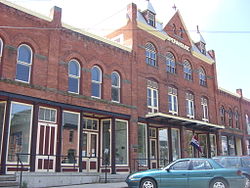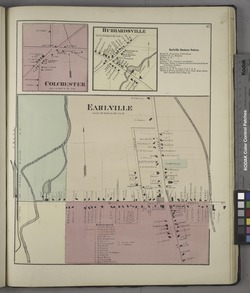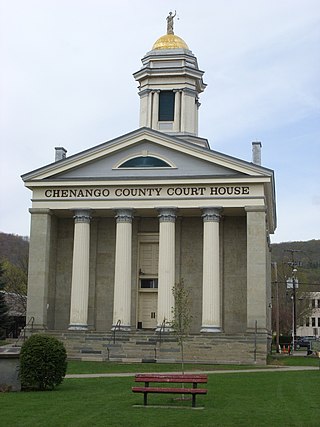
Chenango County is a county located in the south-central section of the U.S. state of New York. As of the 2020 census, the population was 47,220. Its county seat is Norwich. The county's name originates from an Oneida word meaning 'large bull-thistle'. The county is part of the Southern Tier region of the state.

Dickinson is a town in Broome County, New York, United States. The population was 5,083 at the 2020 census. The town was named after Daniel S. Dickinson.

Port Dickinson is a village in Broome County, New York, United States. The population was 1,641 at the 2010 census. It is part of the Binghamton Metropolitan Statistical Area.

Columbus is a town in Chenango County, New York, United States. The population was 975 at the 2010 census. Columbus is in the northeastern corner of the county and is northeast of Norwich.
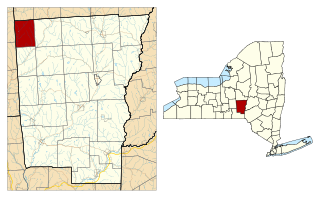
Lincklaen is a town in Chenango County, New York, United States. The population was 392 at the 2020 census. The town was named after Colonel John Lincklaen, an agent of the Holland Land Company and a land owner. The town is in the northwestern corner of the county, northwest of the city Norwich and northeast of Cortland.
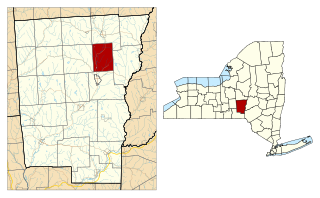
North Norwich is a town in Chenango County, New York, United States. The population was 1,783 at the 2010 census. The town is directly north of the City of Norwich in the eastern half of the county.

Pharsalia is a town in Chenango County, New York, United States. The population was 593 at the 2010 census. The town was named after Pharsalia, which is a commonly accepted name of the decisive battle in the Great Roman Civil War, where Julius Caesar defeated Pompey in 48 BCE.

Preston is a town in Chenango County, New York, United States. The population was 1,044 at the 2010 census. Preston is an interior town of Chenango County and is west of the city of Norwich.
Lebanon is a town on the southern border of Madison County, New York, United States. The population was 1,326 at the 2020 census. The town is believed to be named after Lebanon, Connecticut.

Oriskany Falls is a village in Oneida County, New York, United States. The population was 732 at the 2010 census. The name is derived from a waterfall on a nearby stream. The village is largely in the southeast section of the town of Augusta, but partly overlaps the town of Marshall. The community is at the intersection of routes 12B and 26, which share a brief concurrency within the village and south to Bouckville.

Sangerfield is a town in Oneida County, New York, United States. The population was 2,561 at the 2010 census. The town is named after Jedediah Sanger, an early settler.

Greene is a village in Chenango County, New York, United States. The population was 1,580 as of the 2010 census. The village is named after General Nathanael Greene. It is within the town of Greene and is northeast of Binghamton.

Oxford is a village in Chenango County, New York, United States. The population was 1,450 at the 2010 census. The village is named after Oxford, Massachusetts, the hometown of the landowner.

Sherburne is a village in Chenango County, New York, United States. The population was 1,367 at the 2010 census. It is in the town of Sherburne, north of Norwich.
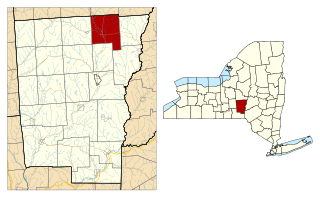
Sherburne is a town in Chenango County, New York, United States. The population was 4,048 at the 2010 census. The town contains two villages, Sherburne and Earlville. The town is at the northern border of Chenango County.
Smyrna is a village in Chenango County, New York, United States. The population was 213 at the 2010 census. The village is located in the town of Smyrna and is near the northern border of Chenango County.

The Village of Hamilton is a village located within the town of Hamilton in Madison County, New York, United States. Notably, it is the location of Colgate University and has a population of 4,239, according to the 2010 census.
Hamilton is a town in Madison County, New York, United States. The population was 6,379 at the 2020 census. The town is named after American Founding Father Alexander Hamilton and is a college town, with Colgate University dominating the town's employment, culture and population.

Madison is a village in Madison County, New York, United States. The population was 305 at the 2010 census. The village and its town are named after President James Madison.

Madison is a town in Madison County, New York, United States. The population was 2,766 at the 2020 census. The village of Madison is the largest community within the town. Madison, along with the rest of Madison County, is part of the Syracuse Metropolitan Area.
